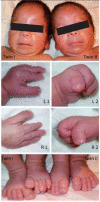Thyroid hypoplasia as a cause of congenital hypothyroidism in monozygotic twins concordant for Rubinstein-Taybi syndrome
- PMID: 21448332
- PMCID: PMC3065314
- DOI: 10.4274/jcrpe.v3i1.07
Thyroid hypoplasia as a cause of congenital hypothyroidism in monozygotic twins concordant for Rubinstein-Taybi syndrome
Abstract
Rubinstein-Taybi syndrome (RSTS), a genetic disorder characterized by growth retardation, mental deficiency, dysmorphic face, broad thumbs and large toes, generally affects monozygotic twins concordantly. Thyroid hypoplasia (TH) is a common cause of congenital hypothyroidism (CH) and often accompanies dysmorphic syndromes. A pair of female twins were admitted to our neonatology unit 16 hours after delivery. They were born at 35 weeks of gestation. Both twins had an unusual dysmorphic facial appearance with microcephaly, as well as broad short thumbs and large toes. Based on the presence of characteristic dysmorphic features, the twins were diagnosed as RSTS. Thyroid function tests in the first twin revealed the following results: free thyroxine (T4) 8.4 pg/mL, thyrotropin (TSH) 4.62 mIU/L, thyroglobulin (TG) 213.24 ng/mL and a normal level of urinary iodine excretion (UIE). Thyroid function test results in the second twin in the second week were: free T4 5.9 pg/mL, TSH 9.02 mIU/L, TG 204.87 ng/mL, and normal UIE levels. Thyroid volumes were 0.36 mL and 0.31 mL in the first and second twin, respectively. TH was confirmed by technetium 99 m pertechnetate thyroid scans in both infants. Thyroid function tests normalized with L-thyroxine replacement therapy (10 μg/kg/day) around the end of the 3(rd) week of life. The infants were discharged planning their follow-up by both endocrinology and cardiology units. The rarity of cases of twins with RSTS (concordant) co-existing with CH led us to present this report.
Keywords: Rubinstein-Taybi syndrome; congenital hyperthyroidism; monozygotic twins; thyroid hypoplasia.
©Journal of Clinical Research in Pediatric Endocrinology, Published by Galenos Publishing.
Figures


Similar articles
-
Congenital hypothyroidism associated with Rubinstein-Taybi syndrome.J Pediatr Endocrinol Metab. 2003 Mar;16(3):457-9. doi: 10.1515/jpem.2003.16.3.457. J Pediatr Endocrinol Metab. 2003. PMID: 12705373
-
Monozygotic twins are generally discordant for congenital hypothyroidism from thyroid dysgenesis.Horm Res. 2009;72(5):320. doi: 10.1159/000245935. Epub 2009 Oct 19. Horm Res. 2009. PMID: 19844119 No abstract available.
-
Thyroid function in Rubinstein-Taybi syndrome.J Clin Endocrinol Metab. 1997 Oct;82(10):3264-6. doi: 10.1210/jcem.82.10.4273. J Clin Endocrinol Metab. 1997. PMID: 9329350
-
Congenital hypothyroidism: recommendations of the Thyroid Department of the Brazilian Society of Endocrinology and Metabolism.Arq Bras Endocrinol Metabol. 2013 Apr;57(3):184-92. doi: 10.1590/s0004-27302013000300004. Arq Bras Endocrinol Metabol. 2013. PMID: 23681264 English, Portuguese.
-
Congenital hypothyroidism.Orphanet J Rare Dis. 2010 Jun 10;5:17. doi: 10.1186/1750-1172-5-17. Orphanet J Rare Dis. 2010. PMID: 20537182 Free PMC article. Review.
Cited by
-
Rubinstein-Taybi syndrome: Clinical profile of 11 patients and review of literature.Indian J Hum Genet. 2012 May;18(2):161-6. doi: 10.4103/0971-6866.100751. Indian J Hum Genet. 2012. PMID: 23162289 Free PMC article.
References
-
- Mujoskovic ZP, Karadaglic D, Stojanov L. Rubinstein-Taybi Syndrome. growth. 2009
-
- Chiang P-W, Lee N-C, Chien N, Hwu W-L, Spector E, Tsai AC-H. Somatic and germ-line mosaicism in Rubinstein-Taybi syndrome. Am J Med Genet A. 2009;149:1463–1467. - PubMed
-
- Wojcik C, Volz K, Ranola M, Kitch K, Karim T, O’Neil J, Smith J, Torres-Martinez W. Rubinstein-Taybi syndrome associated with Chiari type I malformation caused by a large 16p13.3 microdeletion: A contiguous gene syndrome? Am J Med Genet A. 2010;152:479–483. - PubMed
Publication types
MeSH terms
LinkOut - more resources
Full Text Sources
Molecular Biology Databases
Miscellaneous
